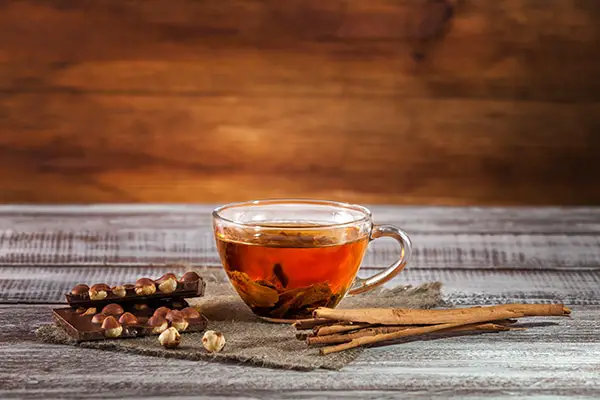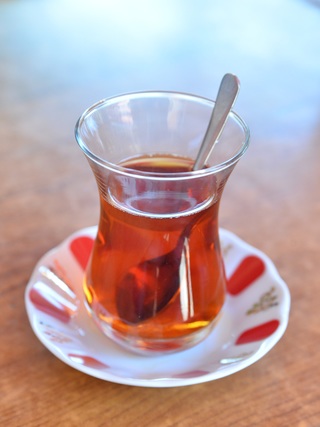
If you have been a tea drinker for any period of time, you will have undoubtedly come across something called Orange Pekoe tea.
It is a rather prevalent type of tea. Like most tea enthusiasts, there is a good chance that you have no idea what this is or what it means.
Well, all your questions are about to be answered in this post.
So, if you have had any queries regarding this particular blend, here is everything that you need to know.
Contents
Let’s begin with the basics – what on earth is orange pekoe tea?
Does it have anything to do with oranges?
Despite its name, Orange Pekoe is actually a black tea.
The name is related to a tea grading system.
This is used by tea manufacturers to identify between the best black tea and more economical options.
You can get a better understanding of where Orange Pekoe tea falls on the spectrum in the section below…

Here is a breakdown of the tea grades starting from the best and moving down to the more commonly available type of black tea.
The teas are largely graded according to their appearance.
This means that graders will look at whether the tea leaves have tips, whether the tips are hairy, and how many of these leaves have hairy tips.
These individuals will look at whether or not the leaves are curled or rolled.
For broken leaves, the letter B is added to the name of the leaves.
For instance BOP is Broken Orange Pekoe while FBOP is Flowery Broken Orange Pekoe.
Even lower on the scale is Fannings (F) and Dust (D).
There is often some confusion in the grading name system as F can signify flowery, fine, or fannings.
However, with fannings, the name is tacked onto the end of the term – Tippy Golden Flowery Orange Fannings.
Needless to say, the name Orange Pekoe is a rather unusual one – particularly since this tea has nothing to do with oranges.
So, where did this title come from?
Only certain elements of the history of Orange Pekoe are set in stone.
To begin with, let’s take a look at the origin of “pekoe”.
In the tea industry, people used the term “white down” to describe young leaf shoots that contain fine, white hairs.
Since tea originated in China, white down was referred to either as “baak-ho”, “biak-hou”, or “pak-hau”, depending on the port.
This was eventually Romanized to pekoe.
Then, what about orange?
Well, many assume that orange refers to the Orange-Nassau monarch family of Netherlands.
The Dutch were one of the most prominent tea importers in the 18th century.
So, when a labeling system for tea was introduced, the Dutch put their own signature label on the tea.
Since Orange Pekoe is essentially a black tea, it has the same list of health benefits.
Due to this, Orange Pekoe may have the following advantages:
Many people automatically assume that orange pekoe has to have at least a hint of orange to it.
As established, though, the fruit has nothing to do with this tea.
Rather, Orange Pekoe is a medium-bodied cup of black tea.
Nevertheless, you should keep in mind that this term is merely refers to a grade of tea.
Orange Pekoe tea can differ in flavor depending on where it is grown and how it is processed.
Furthermore, brewing techniques can also play a role in the resulting cup of tea.
As Orange Pekoe is a black tea, it has a rather high caffeine content.
On average, a single 8 ounce cup can contain up to 50mg of caffeine.
There can be variations between blends. The manner in which you brew your tea can also cause the content to vary.
Thus, you can expect the caffeine content to be around 20mg to 80mg.

Due to the high caffeine content, Orange Pekoe tea should be enjoyed in moderation.
It is best to limit consumption to around two to three cups a day.
Drinking more than this can result in irritability, feeling jittery, and may even impact your sleep.
If you are pregnant or breastfeeding, you should always speak to a doctor before drinking Orange Pekoe.
Orange Pekoe tea is brewed in the same manner as all black teas.
On average, it has a medium-bodied strength.
Many find this grade to have its own, natural sweetness. Due to this, it can be drunk without any additions.
Although, some people do prefer to add a squeeze of lemon.
It is also possible to drink the black tea by adding milk and/or sugar to it.
This is the full story on Orange Pekoe. As you can see, it has been misidentified for quite a while. Despite its name, this is simple a grade of black tea, not a unique blend.
Did you enjoy this post? If you did, you should check out our Pinterest page. You will be able to find information, tips, and tricks on all kinds of tea types and blends.
